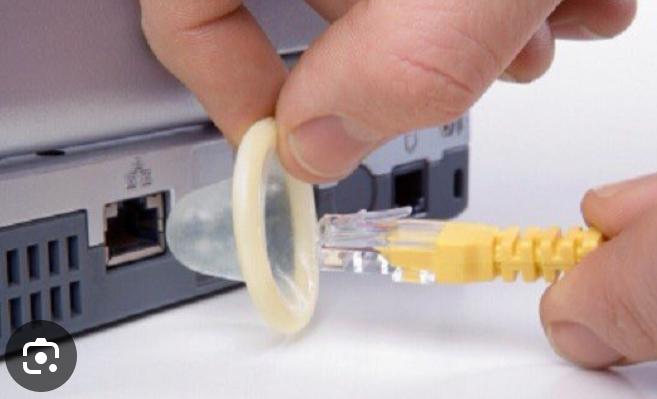Greetings! So recently, i spent a few hours coding software. After i was done and i shut off my pc, i noticed both of the ethernet lights were on and blinking. Does this mean that Microsoft is sending data to their servers before the PC fully shuts off? I am scared that this might be the thing it does. How can i get rid of this issue? I have no idea if it’s related to Windows or the PC itself.
Does your PC support Wake-On-Lan? Effectively, leaving the port powered to allow switching on over the network
It does, but wake on lan is disabled in the BIOS.
Power to the port may be hardwired for that feature to exist even though you have it disabled. Usually older models, but some do stay on just from being powered.
If it’s a privacy concern check at your router and see if it holds an address.
Try toggling ErP setting or similarly named EU energy setting in your UEFI. This should resolve the lights being on.
Windows by default doesn’t fully power off when you tell it to shut down. It goes into hibernation and keeps the network open for updates and will sometimes power back on to complete these updates.
If you want to fully power off, hold the left shift key when you click shut down. Or turn the power off elsewhere (eg. psu or power bar.) I’m sure there’s another way to do it, or to prevent the behavior entirely.
This isn’t correct at all. You are confusing fast boot and sleep. When Windows goes to sleep (I think it is S4) is when it can come back up for updates. However, during sleep networking is not active. It just wakes back up on a timer. Fast boot isn’t sleep at all. It just a fancy shutdown mode that doesn’t unmount the boot disk before shutdown. It also caches the system state to improve the startup time.
Fast boot is just Windows logging you out of your session, then hibernating.
Sleep is keeping the computer in a low-power state with RAM powered on…
Both of these have been known to result in laptops powering on unbeknownst to their owners to perform updates and remain powered on afterward.
Windows is never responsible for this. It is errors in the EC code or BIOS wake timers. When you click shutdown, the system is powered off. Windows hands off execution to Bios code for shutdown after the cycling dots saying “shutdown”.
Your PC network card keeps the connection up in order to receive wake on LAN requests.
Any link activity whilst the PC is shutdown is packets that were broadcasted to the entire network. Other PCs, DHCP requests, etc send traffic to all devices on the network. So seeing some traffic whilst it’s off is nothing to worry about.
the link light is powered by the switch. it doesnt [necessarily] mean data transfer
the link light is powered by the switch
No it’s not. If you don’t believe me, unplug your PC’s power cord and watch the light go out.
If the power cord is plugged in but the computer is shutdown, and the light is still on, then that means the network adapter supports WoL or OOB management and must stay on for that reason, but the network switch connected to the adapter is not physically powering any lights.
If the power cord is plugged in but the computer is shutdown, and the light is still on, then that means the network adapter supports WoL or OOB management and must stay on for that reason
Also worth noting that Windows is especially bad about actually shutting down when you tell it to shut down because something something fastboot. I’ve seen similar inconsistently on Linux but I strongly suspect that to be more edgecases with specific hardware and my install.
Fastboot shouldn’t affect networking as the hardware itself is powered off.
For cameras on some devices, the camera cannot be used without completing a circuit that turns on a light. I think they’re just stating the same is true for the ethernet port light.
Except neither of those things are true.
I don’t know enough about ethernet switches to know if this is common. Though, reading their comment again, I don’t really think I’m right about their statement. It’s definitely a light that is frequently designed to be on when packets are still being accepted for waking the computer.
I don’t have a background in CE, but I’ve seen people claim this is sometimes a design used in the past. I think it makes sense that a circuit that is controlled by the computer can be hard wired to turn on both a light and a ethernet port. Though, I don’t know how common this design is in reality.
edit: After searching some, it looks like some port lights can be controlled by a driver. I still think it probably depends on the hardware design though, and this won’t be consistent between ports.
sure it depends on the design, but no standards-compliant non-PoE Ethernet design is going to light up an LED, it barely uses 1 volt.
I think driver examples from the Linux kernel are very convincing evidence that the lights can be controlled entirely by software, but I’m interested to see any possible specific port designs where that isn’t true.
I was not refuting that, yes drivers can control the LED since forever. The original comment was “the link light is powered by the switch”, which I’m saying is not possible. An ethernet switch (assuming it’s not PoE) cannot directly power an LED on a network adapter in your PC let alone the rest of it, that’s all I’m saying.
this 100% factually incorrect.
i don’t really think so. unplug the power to your PC and the lights will turn off soon
False
You computer has a feature for Out of Band management. Either WoL as others have mentioned or vPro(Intel), iLon(HP), iDrac(Dell), as well a few other less popular systems depending on who makes your mainboard or NIC.
This leaves the power on to the network card so that it can be used even with your computer off. It does not have access to your normal computer in the this case. Just the ability to turn on/off the system and sometimes options to update BIOS/UEFI firmware and send a console image to either a client or browser.
The lights are blinking because broadcasts packets from other devices on your LAN are sent to every device. This is normal and expected behavior.
The lights are blinking because broadcasts packets from other devices on your LAN are sent to every device. This is normal and expected behavior.
Just building off of this, modern computers are chatty as heck and there’s just constantly little bits of chatter spamming out on LANs. This is normal and expected behavior
More rarely: some poorly configured USB controllers can actually provide enough backwash power to the motherboard that some LEDs still blink, like the Ethernet indicators.
I ran into this myself, I notice the lights being on, and they stayed on when I unplugged the computer. Took me a good 5m of debugging to figure it out.
deleted by creator
He needs to install GhostBSD to defeat them.
deleted by creator
Unfortunately Linux doesn’t have any anti-ghost packages as they’re much more common in Windows
ghostscript?
deleted by creator
As other said, it’s surely related to the LAN traffic and not the WAN traffic only your router sends some packets but it shouldn’t be Windows. Little tips if you don’t want telemetry and tracking, simply use Linux.
use Linux
Had to be said, didn’t it?
And always use proper protection when surfing online

Right sorry
I dualboot both Windows and Linux. I use windows just for pyinstaller and compiling, while i daily drive Arch Linux with dwm.
Ok great!
Why windows for pyinstaller and compiling?
Well as you may know, when you try running pyinstaller on linux, it packs the .py file into a linux exectuable, not a windows executable.
Very interesting! Thanks for the heads up. I didnt know that. 7 years ago, they already used wine for that. https://stackoverflow.com/questions/44014390/how-to-generate-a-windows-executable-using-pyinstaller-on-linux#45065125
If all else fails you could also use a vm. Thats probably less dangerous than dual booting because of windows not playing nice with grub.
I dualboot both Windows and Linux using the PC’s boot menu.
Its the other CPU in your cpu/nic
Maybe but probably not. Its just frames coming in from the rest of the network. The device on the other end doesn’t know the computer is off.
Alternatively if the card still has power it might be just in the state Windows left it in. I could imagine it would be good to not have to reinitialize the card all the time.
Why are you concerned about telemetry on shutdown? That wouldn’t make any sense as it sends your data and checks the system status in the background while you use your computer. Also it is not great practice to totally shutdown at night as that’s the time when update happen. It also could theoretically wear out hardware but chances are that’s not a problem on newer machines
Also it is not great practice to totally shutdown at night as that’s the time when update happen.
updates can be installed when it’s turned on, though, and it well consume much less power.
It also could theoretically wear out hardware but chances are that’s not a problem on newer machines
what do you mean? I don’t understand.
if you mean the HDDs spinning down and up, then- if it only happens at shutdown, it shouldn’t wear them out, additionally as I know HDDs (consumer models at least) don’t like endless spinning either
- windows probably shuts it down regularly when it’s not in use. this is a setting in the power profile
- as I know, frequent spindowns only increase wear out if it happens very often, like every 10 seconds and such because of the drive’s garbage internal power saving setting. that’s why I always keep it at least 30 minutes or more
I’ve never seen hardware die because of repeated shutdowns. Also most people aren’t running HDDs these days as flash storage is cheap and plentiful.
For updates you need to be turned on for them to install. That’s why shutting it down isn’t good practice. Just set a maintenance window and put the computer to sleep.
or just install and then shut down?
I’ve never seen hardware die because of repeated shutdowns
then why do you recommend to keep the computer on for a longer life?
but in the case of hard drives, this is a real thing, just not at that scale of shutdowns. if you don’t find sources on this let me know and I’ll show some.
For updates you need to be turned on for them to install. That’s why shutting it down isn’t good practice. Just set a maintenance window and put the computer to sleep.
of course, the installation will get prepared while the computer in on. it will have plenty of time being turned on.
but most updates, including a lot of security updates only apply when restarting the updated software, like shutting down the operating system.
no Linux?
i noticed both of the ethernet lights were on and blinking
So usually one of the lights on the port indicates the link state (up/down and if its at full speed or a reduced speed) and the other light indicates data flow. Both lights blinking suggests either a really shoddy link state or an unusual implementation of status lights on the port. Do both lights blink while its booted and actively transferring a large file? Can you find documentation of how your device implements the indicator LEDs? (I can’t tell if that’s a dongle or a port on your computer)
I’m sure it’s legacy thing from back in the day, flashing means it’s sending or receiving, solid means it’s idle.
I believe you can stop it by turning off a feature called “fast startup” or something like that.
deleted by creator
disconnect ur pc from power physically if the behavior continues which i would guess it will its probably something connected to ur wifi doing something in a dumb way if it stops thats wierd as fuck but forcing the pc to shut down by holding the power button should do the trick since that usually tells the motherboard to tell the power supply to shut off and i dont think windows gets a say on that.











